
When capturing outdoor vehicle photography, the role of lighting cannot be overstated. The quality and direction of light significantly influence the aesthetic appeal and overall impact of the images. Natural light provides a rich canvas that can enhance the vehicle’s design while showcasing the surrounding terrain, making it crucial for photographers to understand how to utilize it effectively.
Different times of day can dramatically alter the way a vehicle appears in photographs. Golden hour, typically the hour after sunrise and before sunset, offers a soft, warm light that highlights curves and details in vehicles, while also casting appealing shadows across the terrain. This time of day can create a sense of depth and drama, transforming an ordinary scene into something extraordinary.
In contrast, midday sun can lead to harsh lighting conditions, producing strong shadows and overexposed highlights that may do little to flatter the vehicle or the surrounding landscape. Photographers must adapt to these challenges by finding shaded areas or using techniques such as reflectors to manipulate light, ensuring that the vehicle remains the focal point against the backdrop of the rugged terrain.
Understanding the nuances of lighting allows photographers to not only showcase the vehicle itself but also highlight its relationship with the environment. The interplay between light and shadow reveals textures, colors, and shapes, enriching the narrative of the photograph. Mastering these elements is essential for anyone looking to elevate their outdoor vehicle photography.
Understanding Natural Light Conditions for Optimal Vehicle Shots

Natural lighting plays a crucial role in outdoor vehicle photography, significantly impacting the quality and appeal of the final images. Different lighting conditions markedly affect how a vehicle looks in photographs, thus understanding these conditions is essential for capturing stunning shots.
The golden hours, shortly after sunrise and before sunset, are often regarded as the best times for outdoor photography. During these periods, the sunlight is softer and warmer, creating a flattering glow that enhances the vehicle’s curves and details. Shadows are elongated, adding depth and texture, making the vehicle appear more three-dimensional.
On the other hand, midday sun can produce harsh lighting, resulting in stark shadows and high contrast that can obscure finer details of the vehicle. Utilizing shaded areas or overcast days can help mitigate these effects. Cloud cover acts as a natural diffuser, softening the light and providing a more even illumination that highlights the vehicle without harsh reflections.
Additionally, understanding the direction of the light is vital. Side lighting can accentuate the contours of a vehicle, while backlighting can create dramatic silhouettes. Experimenting with different angles relative to the sun can yield diverse results, allowing photographers to showcase the vehicle’s design uniquely.
Finally, the surrounding environment must also be considered. Reflections from nearby surfaces can influence the lighting on the vehicle. Utilizing natural elements such as trees, water, and buildings can aid in controlling reflections, leading to more controlled and appealing lighting conditions.
Utilizing Shadows and Reflections to Enhance Vehicle Features

In outdoor vehicle photography, effective use of lighting can dramatically influence the visual appeal of a car. Shadows and reflections are crucial elements that can enhance the features of a vehicle, adding depth and dimension to the images. By strategically positioning the vehicle and manipulating light sources, photographers can create compelling compositions that highlight the car’s unique design elements.
Shadows play a pivotal role in defining the contours and shapes of a vehicle. When light casts shadows across the surface, it can accentuate curves and lines, making the car appear more dynamic. For instance, shooting during the golden hour, when the sun is low on the horizon, produces longer shadows that can enhance the contours of the vehicle. This natural gradient in lighting can separate the car from the background, creating an appealing focus that draws the viewer’s eye.
Reflections also serve as a powerful tool in outdoor vehicle photography. The reflective surfaces of a vehicle, such as windows, chrome details, and polished paint, can mirror surrounding elements like landscapes or structures. By carefully selecting the environment and adjusting the angle of the shoot, photographers can incorporate these reflections to add context and storytelling to the image. Reflections can create a sense of place, connecting the vehicle to its environment and emphasizing its aesthetic qualities.
Combining shadows and reflections can lead to striking visual effects. For example, capturing a vehicle positioned near a body of water can yield stunning reflections that double the impact of the image. Meanwhile, shadows can add layers to the visual narrative, directing the eye towards key features like headlights, grilles, or wheel rims. This dual emphasis not only enhances the car’s appearance but also engages the viewer on a more intricate level.
To effectively utilize shadows and reflections, photographers must remain mindful of the overall lighting conditions. Experimenting with different angles and times of day can reveal various aspects of a vehicle that may otherwise go unnoticed. Additionally, utilizing tools such as reflectors or diffusers can help modulate harsh lighting, allowing for softer shadows and more balanced reflections.
In conclusion, embracing shadows and reflections in outdoor vehicle photography can significantly elevate the quality of images. By understanding the interplay between lighting, shadows, and reflections, photographers can create works that truly highlight the beauty and features of a vehicle.
Adapting to Different Terrains for Creative Lighting Solutions
When photographing vehicles outdoors, lighting plays a crucial role in determining the overall quality and impact of the images. Different terrains pose unique challenges that require creative lighting solutions. Understanding how to adapt your lighting techniques to varying environments can enhance your photographs and emphasize the vehicle’s features.
In wooded areas, dappled sunlight can create interesting patterns on the vehicle’s surface. Utilize reflectors or diffusers to soften harsh shadows and balance the light. Positioning the vehicle near openings in the foliage can allow natural light to illuminate it without overwhelming the scene, highlighting its silhouette against the natural backdrop.
On sandy or rocky terrains, the open sky can provide strong, direct sunlight. To manage this, consider shooting during the golden hour, when the light is warm and softer. A fill flash or a portable light source can help expose the shadows on the vehicle, maintaining detail in both highlights and dark areas. This balance can dramatically improve the visual appeal of the vehicle.
In mountainous regions, the dramatic landscape can serve as a natural backdrop. However, the varying elevations and angles of the sun can create challenging lighting conditions. Position the vehicle to take advantage of the sun’s position, using shadows to your advantage. Experiment with both backlighting and side lighting to achieve dynamic images that highlight the vehicle’s contours and the rugged terrain.
Urban environments often have reflective and diffusive surfaces that can influence lighting. Using the buildings and pavement to bounce light can enhance the vehicle’s features. Nighttime photography in cities can open up opportunities for creative lighting with artificial sources, such as streetlights and neon signs, adding a contemporary flair to the vehicle images.
Each terrain offers opportunities to creatively manipulate lighting, enhancing the overall aesthetic of outdoor vehicle photography. By understanding these environmental influences and adapting your techniques accordingly, you can transform simple shots into captivating visuals that showcase both the vehicle and its surroundings effectively.





